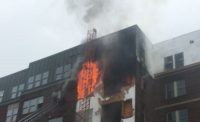Structural fire engineering is heating up in the U.S. and Europe, thanks in large part to the "traveling fires" observed on Sept. 11, 2001, at the World Trade Center. Structural and fire-protection engineers, aware that current design assumptions do not reflect the behavior of large fires in open-plan office spaces, are developing tools to prevent unprotected structures from collapsing under extreme fire loads.
"I very much believe that certain structures should be analyzed for fire exposure" when there are specific threats or there is a high consequence of failure, says Kevin J. LaMalva, a structural and fire-protection engineer with Simpson, Gumpertz & Heger, Waltham, Mass.
As a member of the American Society of Civil Engineers fire-protection technical committee, LaMalva is co-authoring "Performance-Based Design Procedures for Fire Effects on Structures." The PBD guide is intended as a non-binding appendix for the 2016 edition of the standard "ASCE/SEI 7: Minimum Design Loads for Buildings and Other Structures."
The proposed appendix and commentary set forth performance criteria and evaluation methods for structural systems exposed to significant fires, such as traveling fires or other fires large enough to threaten the structural system.
Structural fire engineering—the interface between fire dynamics and structural engineering—is a relatively young discipline. This would be the first time fire is considered as an explicit load, like wind or seismic, in a U.S. standard.
"There is no such guidance for structural engineers in the U.S.," says Therese McAllister, a research structural engineer at the National Institute of Standards and Technology, Gaithersburg, Md., and LaMalva's co-author. Building officials need guidance to help early adopters with the approval of proposed PBDs, she adds.
When it comes to large-floor-plate open-plan office space, the 9/11 fires revealed that model building codes' prescriptive provisions are flawed. Traditional methods for specifying fire load on the structure erroneously assume uniform burning and homogenous temperature conditions throughout a compartment, regardless of its size.
That's not the condition in a traveling fire, in which the "flame front" spreads around the floor plate, toward openings such as broken windows, to oxygen. As it travels, the fire burns out as it consumes flammable contents, but there is no cooling behind the flames. Smoke, ahead of and behind the flames, actually preheats and post-heats the structure, causing it to lose strength.
In the U.K., researchers at the University of Edinburgh, sponsored by a $100,000 grant from multidisciplinary engineer Arup, developed a PBD method to keep large-compartment structures standing, even in an unfought fire. The work, finished in 2010, was inspired by the fires set by the highjacked plane attacks on the World Trade Center (WTC).
The fires traveled, defying design assumptions in place for 100 years. "We were surprised and at first thought it was an anomaly," says Guillermo Rein, who led the Edinburgh research and is currently a professor of mechanical engineering at Imperial College, London.
The WTC fires were troubling, adds Rein. Large-compartment fires last longer and produce more heat, though they burn over a limited area at any one time.






Post a comment to this article
Report Abusive Comment